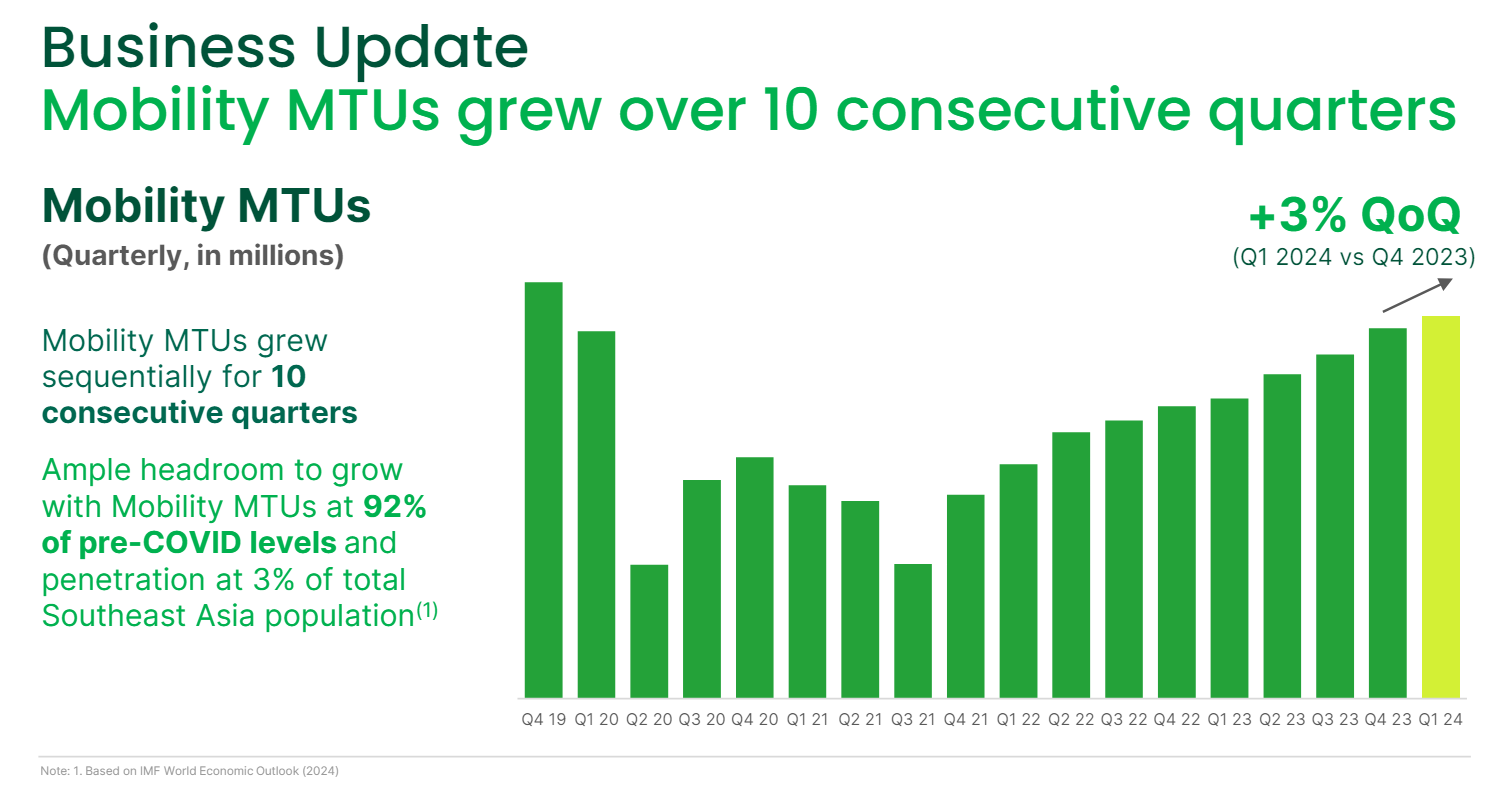

登錄


登錄
海擇短評 Haize Comment:
近期Grab(MASDAQ: GRAB)公告2024Q1財報,市場投資人最好奇的是,Grab是否能複製Uber(NYSE: UBER)的成長路線,成為網約車市場的印鈔機。不過,即便用相同商業模式複製圈地,基於文化差異與貧富差距,也可以能橘逾淮為枳;最好的範例是,西方的Booking在2023Q4電話會議時,是把創歷史新高的員工股期權支出認定是公司競爭力,而本季Grab的電話會議,則將降低股期權支出,並將此認定為公司競爭力。若將Uber當成模板,海擇資本認為可以關注Grab相對於Uber有什麼弱點、有什麼護城河,以及人工智慧能帶來什麼。海擇資本依此分析如下:
1. 難以全然複製Uber:本季Grab在Adjusted EBITDA為6,200萬美金,YoY虧轉盈,QoQ成長42%。不過,在Q4運營轉盈後,Q1又陷入運營虧損(7,500萬美金);各部門單獨財務中心的總結算1.53億美金,也較Q4減少33%。從上述數據大體可以理解,Grab在從EBITDA轉盈邁向GAAP轉盈的過程中,並不像Uber那麼不受季節性因素的影響。歸根究底來說,網約車與配送的商業模式在於用騎手的時間換取消費者的時間,依賴於龐大的貧富差距,而這在東南亞還沒有被驗真;而Grab能選擇的作法,目前是在網約車與配送的產品線,針對不同消費能力的客戶推出不同產品,比如將配送服務分解成"Saver delivery"、"Standard delivery"、"Priority delivery"三種,用Saver delivery推動訂單數,用Priority delivery帶動EBITDA利潤率。
2. 嘗試將"旅遊事業"建為護城河:Grab在本次電話會議,也更清楚的說明了"旅遊"對Grab的價值。除了與旅遊局(如:泰國旅遊局)的常規合作,B2B分銷與B2C直銷的貢獻也漸成規模,特別B2B部分已與攜程(NASDAQ: TCOM)、支付寶、微信和Booking(NASDAQ: BKNG)合作,在國際機場的接送服務量能不錯。從數據看,本季集團整體的支付用戶數為3,850萬,YoY增速16%;網約車這類隨選服務的支付用戶數,YoY增速19%;而來自B2B與B2C旅遊用戶的支付用戶數,增速達69%,是驅動支付用戶成長的主力。Grab也說明,旅遊客戶對其來說屬於"高端"用戶,每天在Grab上的花費大約是國內用戶的2倍;不過,公司沒有透露季度的旅遊用戶數與潛在市場大小。
3. 人工智慧用於旅遊場景:相對於Chat Robot的常規使用,Grab本季也透露了在人工智慧的使用深度。當前Grab在泰國6個核心市場推出了語言翻譯功能,更便利旅遊者在目的地使用Grab的網約車及配送服務;公司說明由於不再需要將翻譯服務外包給外部供應商,不但節省大量成本,在各市場內引入新語言的時間,也從100天減少到5天。海擇資本認為,雖然競品也能用各家的大語言模型做到類似功能,不過Grab有品牌優勢,同時也能結合各個景點提供"AI+X"的服務,不無可能在旅遊領域建立先行者優勢;主要問題在於,如何讓通過B2B分銷使用Grab的客人,轉化到Grab的主APP。
-------
Recently, Grab (NASDAQ: GRAB) released its Q1 2024 financial report, and investors are curious whether Grab can replicate Uber's (NYSE: UBER) growth trajectory to become a cash cow in the ride-hailing market. However, even using the same business model, cultural differences and economic disparities might hinder exact replication; an example is the West's Booking.com, which in its Q4 2023 earnings call attributed historically high expenses for employee stock options as a competitive strength, whereas Grab's recent call highlighted reducing such expenses as a boost to its competitiveness. Haize Capital suggests using Uber as a benchmark to assess Grab's weaknesses, competitive advantages, and potential benefits from artificial intelligence, and provides the following analysis:
1. Grab struggles to fully replicate Uber: This quarter, Grab reported an adjusted EBITDA of $62 million, turning a year-over-year loss into a profit, and growing 42% quarter-over-quarter. However, after turning operationally profitable in Q4, it slipped back into an operating loss of $75 million in Q1. The summary of separate financial centers across departments totaled $153 million, a 33% decrease from Q4. This indicates that Grab's progress from EBITDA profitability to GAAP profitability is more susceptible to seasonal variations than Uber. Fundamentally, the ride-hailing and delivery business models trade driver time for consumer time, relying on significant economic disparities, a concept yet to be fully validated in Southeast Asia. Currently, Grab's strategy in its ride-hailing and delivery lines involves catering to different consumer spending capacities with products like "Saver delivery," "Standard delivery," and "Priority delivery," using Saver delivery to boost order volume and Priority delivery to enhance EBITDA margins.
2. Grab aims to build "travel" as a competitive moat: In its recent earnings call, Grab clarified the value of "travel" to its business. Beyond regular collaborations with tourism authorities like the Tourism Authority of Thailand, the contributions from B2B distribution and B2C direct sales are scaling up, especially the B2B segment which has partnerships with Trip.com (NASDAQ: TCOM), Alipay, WeChat, and Booking.com (NASDAQ: BKNG), showing strong performance in airport transfer services. The data shows that this quarter, the total number of payment users for the group is 38.5 million, a 16% YoY increase; payment users for on-demand services like ride-hailing grew by 19% YoY; while payment users from B2B and B2C travel increased by 69%, driving the growth in payment user base. Grab also noted that travel customers are considered "premium" users, spending about twice as much daily on Grab compared to domestic users; however, the company did not disclose the quarterly number of travel users or the potential market size.
3. AI in travel scenarios: Beyond conventional use of chatbots, Grab has deepened its AI application this quarter. It launched a language translation feature in six core markets in Thailand, enhancing the convenience for travelers using Grab's ride-hailing and delivery services. The company reported significant cost savings and reduced the time to introduce new languages in various markets from 100 days to just 5 days, as it no longer outsources translation services. Haize Capital believes that while competitors can also utilize large language models for similar functions, Grab has a brand advantage and the potential to combine "AI + X" services with various attractions, possibly establishing a first-mover advantage in travel. The main challenge lies in converting customers who use Grab through B2B distribution to the main Grab app.

標籤 Label: GRAB UBER GOTO Ride-hailing Delivery Travel AI